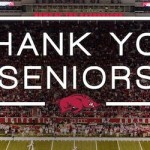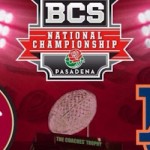 When Auburn quarterback Nick Marshall pulled up on a roll-out just inches from the line of scrimmage and fired a pass toward the left sideline for a wide-open Sammie Coates, who scored the tying touchdown against then No. 1 Alabama with only seconds to spare, I flashed back to an Arkansas game of 1980 in Little Rock. Houston’s quarterback at the time, Terry Elston, pulled the same maneuver on the opposite side of the field against the Hogs in a 17-10 Cougars win.
When Auburn quarterback Nick Marshall pulled up on a roll-out just inches from the line of scrimmage and fired a pass toward the left sideline for a wide-open Sammie Coates, who scored the tying touchdown against then No. 1 Alabama with only seconds to spare, I flashed back to an Arkansas game of 1980 in Little Rock. Houston’s quarterback at the time, Terry Elston, pulled the same maneuver on the opposite side of the field against the Hogs in a 17-10 Cougars win.
Houston in those days was running the veer option. It probably didn’t run any better than it did when the Cougars first joined the old Southwest Conference in 1976 with Danny Davis at the helm. Every Cougar quarterback that followed in the Bill Yoeman era, including Elston, seemed to be in the mold of Danny Davis (and, by the way, the Cougars made a big recruiting run at Pine Bluff’s Danny Bradley about that time, too, as he also was the perfect running quarterback with a good arm as he would show at Oklahoma in 1984).
Nick Marshall would fit the Danny Davis mold as well: fast, deft with the fakes and handoffs, and quick of mind with the defensive reads in sparking a high-octane offense.
Marshall has the perfect complement in the durable and fast running back Tre Mason. In the 13th of his sophomore season on Saturday, Mason carried the ball 42 times for 304 yards in Auburn’s 59-42 win over Missouri.
However, Auburn’s presence in the SEC Championship Game in Atlanta wouldn’t have been possible without Marshall’s pass to Coates the week before to tie Alabama. Chris Davis’ 109-yard return of ’Bama’s missed field goal as time expired wouldn’t have happened.
I’d suspect that Auburn coach Gus Malzahn, who was just a teenager in Fort Smith in 1980, probably saw the Houston veer-option attack and maybe saw that aforementioned pass that helped beat Arkansas, at least on “The Lou Holtz Show” the next day if he wasn’t at the game itself.
It’s part of that vast knowledge of football he’s stored in that brain of his since he first thought of being a coach.
On Saturday, CBS’ analyst, Gary Danielson, noted the similarity with what Malzahn is doing now with Auburn’s offense and the old wishbone offenses made popular by Texas, Alabama and Oklahoma through the 1970s, when Malzahn was but a kid.
Danielson also brought up the nugget publicized here before of Malzahn studying the book on the Delaware Wing-T offense that dated to the 1950s. His offense at his first head coaching job, Hughes High School, was based on that scheme with some modern tweaks. Malzahn has returned to those basics again with a quarterback who can outrun most any other in the land but is plenty dangerous when he chooses to pass. A retro Danny Davis, if you will.
Marshall obviously can throw — but why bother when the run game is piling up nearly 600 yards against what was, before Saturday evening, the No. 2-ranked run defense in the SEC.
A year ago, before Malzahn had coached a game at Arkansas State in his first college head coaching gig, I mentioned to him before one of his speaking engagements that I didn’t believe anyone in this state (outside of a handful of folks) understood what he was about as an offensive innovator.
When Houston Nutt was urged to hire Malzahn as his offensive coordinator in 2006, the impression was that the Razorbacks with Darren McFadden, Felix Jones and Peyton Hillis would soon be flinging the ball all over the field in a pass-happy attack and in such a rapid pace that everyone would be gassed, including the Hogs’ defense. I’m pretty sure Nutt believed that as well.
At Tulsa, Malzahn did have the Golden Hurricane putting up nation-leading offensive totals with lots of passing — because that’s what Tulsa did best with quarterback Paul Smith.
Auburn came out with guns a-blazin’ with Chris Todd, a spread-formation-style quarterback, when Malzahn was hired away from Tulsa by then first-year Tigers head coach Gene Chizik.
But then Cam Newton arrived on the Plains in 2010, and Newton was only throwing about 14-15 times a game (usually completing 11 or 12 of them, often for touchdowns) and running through the tackles or setting up Onterrio McCalebb and others for big gains on the edge. Even media folks I knew who had been around Malzahn’s championship Springdale program were saying, “Gus isn’t being allowed to run his offense. This isn’t his offense.”
How wrong all those folks were. Whatever might suit the talent on hand is what becomes Malzahn’s offense of the day. Today, those strengths are focused around a ton of speed and a running game that improved exponentially as the Auburn season rolled on.
Malzahn has developed all of this through 20-plus years of coaching, creating not an offense but a philosophy that is geared to get a defense off-balance and out of position. He’s added the no-huddle, hurry-up (or slow-it-down, as the case may be) pace, and when the pieces are right, it’s as relentless as we see the Tigers now, as surprise champions of the SEC.
Eventually, the Delaware wing-T gave way to “pro” sets and I-formations, and later on defenses caught up to the Houston veer option and the Texas wishbone. We saw the “wildcat,” another Malzahn innovation with Nutt in 2006, provide a change of pace to the same ol’ power attacks. We’ve seen spread offenses these days, like Baylor’s, rack up 70 points in consecutive weeks, but eventually somebody has the players to stop it. This is the standard story with every offensive scheme that has, for a time, taken the game by storm.
Ultimately, what would be able to stop Auburn’s offense is a matchup with better athletes on the defensive side. That may be the case when the Tigers battle Florida State in the last BCS Championship Game on Jan. 6. But, with nearly a month to prepare, expect Malzahn to have an excellent scheme in place.













